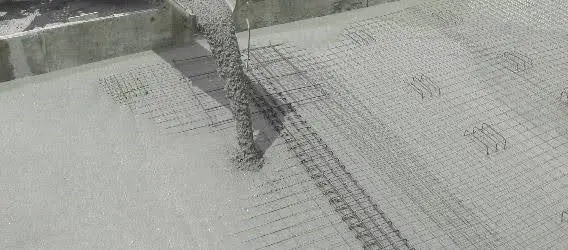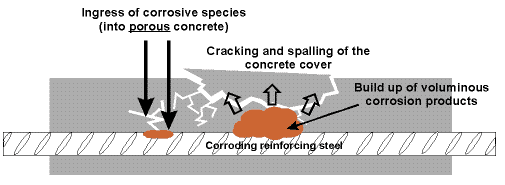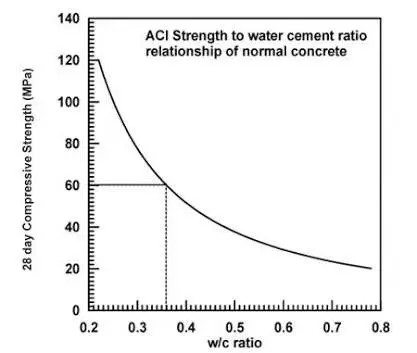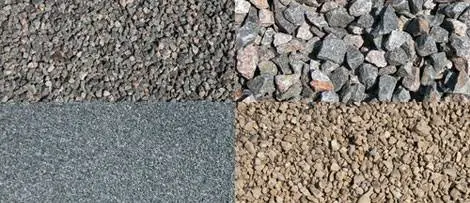Concrete is the most widely used man-made construction material in the world. Concrete is in general obtained by mixing cementing material, water and aggregates. This mixture after preparation when placed in forms and allowed to cure hardens into a rock like mass called as concrete. The strength, durability, workability and other characteristics of concrete depend upon the properties of mix, the method of compaction and other factors during placing and curing.
Concrete of different qualities can be obtained by using its constituents namely, cement, water, fine aggregates and course aggregate in different proportions. The common method of expressing the proportions of the materials in a concrete mix is in the form of ratios of cement, fine aggregates and coarse aggregates (1:2:4 :: cement: 2 fine aggregate: 4 coarse aggregate).
Concrete Mix Design
Design of concrete mix for a particular grade of concrete involves proper selection of relative proportions of cement, sand, and coarse aggregates. While designing a concrete mix, it is always tried to obtain a minimum strength which is equal to characteristic strength of concrete but concrete must have the desired workability and durability. Concrete mix design is mainly classified as;
- Nominal Mix Concrete
- Design Mix Concrete
1. Nominal Mix Concrete
This is a very rough method of concrete mix design. It works in form of ratios(by volume) of cement:sand:aggregates and water to be used per 50kg/unit of cement, no lab testing is required in this mix design. Nominal mix concrete can only be used in ordinary concrete construction involving concrete grade not higher than M15, for higher grades of M20 design mix is adopted. Nominal mix design works on volumetric batching.
2. Design Mix Concrete
Design mix concrete is based on the principles of mix design and is always preferred over nominal mix of concrete. It yields concrete of desired quality and is more economical than the nominal mix. Laboratory testing is done of the constituents before the mix and is done mainly by weight batching.
Factors Affecting the design Mix of Concrete
1. Compressive Strength of Concrete
The grade designation gives characteristics compressive strength requirements of the concrete. As per IS 456-2000, the characteristic compressive strength is defined as that value below which not more than 5% of the test results are expected to fall. It is the major factor influencing the mix design. It is one of the most important properties of concrete and influences many other desirable properties of the hardened concrete.
The mean compressive strength required at a specific age, i.e. 28 days, determines the nominal water-cement ratio of the mix. Depending on the degree of control available at the site, the concrete mix has to be designed for a target mean compressive strength which higher than the characteristic strength.
2. Workability of Concrete
The workability of concrete for satisfactory placing and compaction is controlled by the size and shape of the section to be concreted, the quality and spacing of reinforcement, and the methods to be employed for transportation, placing and compaction of concrete.
The aim should be to have the minimum possible workability consistent with satisfactory placing and compaction of concrete. It should be kept in mind that insufficient workability resulting in incomplete compaction may severely affect the strength, durability and surface finish of concrete the degree of workability required depends on three factors.
For the narrow and complicated RCC section with numerous corners or inaccessible parts, the concrete must have a high workability so that full compaction can be achieved with a reasonable amount of effort.
This also applies to the embedded steel sections. The desired workability depends on the compacting equipment/s (needle vibrators – different sizes, surface vibrators, shutter vibrators etc.) deployed at the site.

3. Durability of Concrete
The durability of concrete can be defined as the resistance to deterioration due to aggressive environment. The requirements of durability are achieved by restricting the minimum grade of concrete, minimum cement content and the maximum water cement ratio.
In the situations when the high strength is not necessary but the conditions of exposure are such that high durability is vital, the durability requirement will determine the water-cement ratio to be used ,type of cement ,inclusion of chemical and mineral admixture in a concrete mix.

4. Water-Cement ratio
The compressive strength of concrete at a given age under normal temperature depend primarily on the water-cement ratio, lower the w/c ratio greater is the compressive strength and vice versa. A number of relationships between compressive strength and water cement ratio are available. In so far as the selection of the w/c ratio for the target compressive strength at 28 days is concerned.

5. Nominal Size of Aggregate
The maximum nominal size of aggregate is determined by the sieve analysis and is designated by the sieve higher than the largest size on which 15% or more of the aggregate is retained. The maximum nominal size of aggregate to be used in concrete depends by the size of section and the spacing of reinforcement.
According to IS 456:2000 and IS 1343:1980 the maximum nominal size of the aggregate should not be more than one fourth of the minimum thickness of the member, and it should be restricted to 5mm less than the minimum clear distance between the main bars or 5mm less than the minimum layer cover to the reinforcement.
In general, larger the maximum size of aggregate, smaller is the cement requirement for a particular water-cement ratio, because the workability of concrete increases with increase in maximum size of the aggregate. However, the compressive strength tends to increase with the decrease in size of aggregate. IS 456:2000 and IS 1343:1980 recommend that the nominal size of the aggregate should be as large as possible. 10-20mm size of aggregate is preferable.

6. grading of Combined Aggregate
The relative proportions of the fine and coarse aggregates in a concrete mix are one of the important factors affecting the workability and strength of concrete. For dense concrete it is essential that the coarse and fine aggregates be well graded, giving the maximum packing density. The grading of aggregate influences the mix proportions for a specified workability and water-cement ratio. Coarser the grading, leaner will be mix as coarser grading contributes less surface area thus lower cement consumption.
7. Quality Control At Site
The strength of concrete varies from batch to batch over a period of time. The variability in the strength of concrete may be considered due to variation in the quality of the constituent materials – particle size and grading, variations in moisture content of aggregates, variations in the quality of batching and mixing equipment available, and the quality of workmanship.
These variations are inevitable during production to varying degrees. Controlling these variations is important at site/field. The factor controlling these site variables is quality control.
The degree of control can be estimated statistically by the variations in individual test results. The variation in strength results from the variations in the properties of the mix ingredients and lack of control in batching, mixing, placing, curing and testing.
The lower the difference between the mean and minimum strengths of the mix lower will be the cement-content required. The factor controlling this difference is termed as quality control.
– Anand Singh





